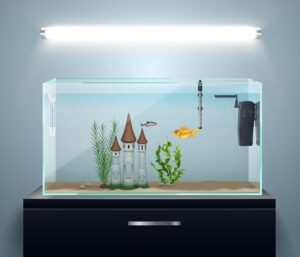The basics for successfully keeping fish can be summarized as follows:
Research your pet fish’s environment to facilitate duplicating it within your aquarium. Locate your aquarium in a consistent environment while still enjoying your fish. Population density is crucial to a happy tank, even more so than fish species. The temperaments of fish species within the aquarium population shouldn’t be mixed. Aquarium equipment selection, fish tank size, and aquarium supplies.
Research first:
You should spend the majority of your time researching your aquarium fish tank environment prior to making any purchase; Do you want freshwater fish or saltwater fish? A few big fish, or plenty of smaller fish? Are the fish you want to keep mostly passive or aggressive? The answers to these questions will dictate the size and type of aquarium equipment and fish tank supplies you need.
Location:
The first thing you should consider in your research is the placement of the fish tank in your home. You want to keep it out of direct sunlight and away from air conditioning and heater vents, but not out of sight. You want to be able to enjoy your Clownfish, Guppy fish, Angelfish, Goldfish, or Pufferfish while keeping the tank at a regular temperature and not encouraging the growth of algae, which is able to rob the water of oxygen and stress your pet fish.
How many fish?
The overall rule of thumb is “1 inch of fish per gallon of the fish tank”. So 10 fish of 2-inch size should be fine in a 20-gallon fish tank. However, this rule is usually true in that it refers to the adult size of the fish, not the size of the fish at the time of acquisition, as they’re usually younger and smaller. As an example, if you get a 2-inch cichlid, it might grow to 7 inches or more in 2 years’ time. In my opinion, this rule ought to be “1 inch of adult-size fish per 2 gallons of the fish tank” for beginners. My suggestion is that this rule should only be used for passive fish, as aggressive fish typically won’t tolerate such a tight population density.
Types of fish –
Freshwater fish are generally easier for kids and busier adults to stay as they’re more tolerant of fluctuations in their environment and able to withstand longer periods between water changes. However, saltwater fish is even as easy to stay if you select your fish and put together your equipment carefully. Fish temperament, size, and area needs must be taken into consideration. Betta fish (a.k.a. Siamese fighting fish) will not tolerate most other fish at all, whereas Oscars, Discus, and Cichlids, while aggressive, can tolerate other fish tank fish, though they’re going to harass or eat, smaller fish species in dense fish tank populations. Try not to mix fish temperaments inside your fish tank to reduce fish stress.
Aquarium equipment:
Finally, the question of what fish tank to get is: what size fish tank should I get? Most beginners should start out with, at least, a 55-gallon to 75-gallon aquarium for saltwater fish or a 20-gallon to 30-gallon fish tank for freshwater or tropical fish. The volume of water in the fish tank contributes to the stability of the aquatic environment; the bigger the tank, the more stable the water temperature and quality. For beginners and experts alike, I recommend fish tank kits, as these usually consist of fish tank filters, pumps, and other compatible equipment that has been pre-configured by the distributors for best performance in many typical situations. You’ll also want a Water Chemistry kit, water conditioners, fish tank heater, and/or chiller, depending upon your location and typical temperature within your home.
This is not a comprehensive discussion, but it will cover the items most frequently overlooked by beginners. If additional hobbyists would follow these basic guidelines within the setup of their fish tanks, they would pay longer to enjoy their pet fish rather than struggling with algae, fish disease, and replacing dead fish.




